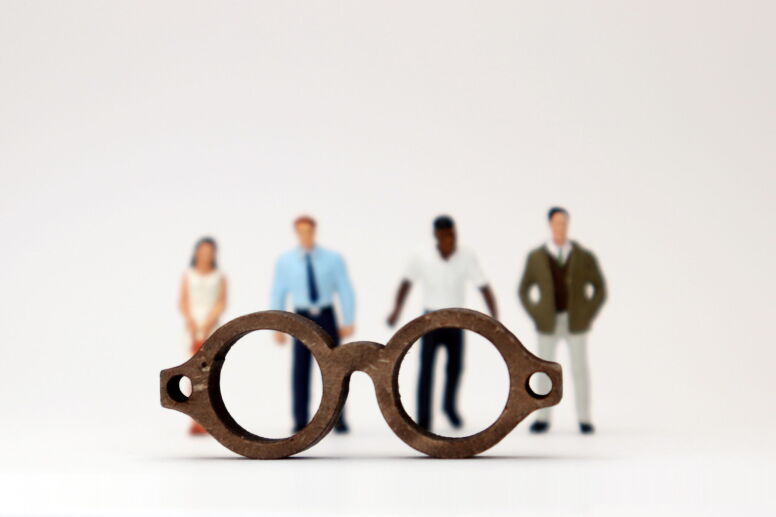News & Stories
Through the looking glass

Researchers use the metaphor of lenses to help explain how the stereotypical views we hold of others – based on race, gender, age, sexual preference and other social categories – can often distort the ways we perceive them.
But studies have produced curious contradictions. In some cases, two groups, such as gay Black men and heterosexual Black men, could be perceived very differently and in other cases very similarly. These contradictions show up most often when considering intersectional identities – when the lens involves multiple social categories – such as gender and race – instead of a single category.
Helping resolve these contradictions is research by Christopher D. Petsko, assistant professor of organizational behavior at UNC Kenan-Flagler Business School, with Ashleigh Shelby Rosette of Duke University and Galen Bodenhausen of Northwestern University.
Their research also suggests potential approaches for avoiding bias from negative stereotypes, which could help companies seeking to reduce bias in hiring, promotion and other business decisions.
They published their research in the article “Through the Looking Glass: A Lens-Based Account of Intersectional Stereotyping” in the Journal of Personality and Social Psychology.
Pick your lens
In a series of experiments, Petsko and his colleagues tested three fundamental questions to tease out how and why stereotypes seem to influence perceptions of others differently in different situations.
- When thinking about people with intersectional identities, do people sometimes pay attention to just one of their identities? For example, when thinking about older women, are there situations where people might use only the lens of gender?
- Do the stereotypes people have about others depend on which lens they are using in the moment?
- Can people hold stereotypes based on intersectional lenses or are stereotypes triggered based solely on single identities?
To test the first question, the researchers conducted two experiments where they had study participants review conversations between groups of people with different races, genders and ages. They manipulated the lens people were likely to use – age, race or gender — and then tested how well participants remembered the content of the conversations.
Participants’ memory errors corresponded to the lenses they were using. That is, when they were using the lens of age, they had an easy time remembering whether the people who’d spoken had been old versus young, but they had a much harder time remembering whether the people who’d spoken had been men versus women. This suggests that the participants were more focused on age than other social categories.
In a second pair of experiments, Petsko and his colleagues tested whether the stereotypes people held matched the lens they were using in the moment. They used an implicit bias test to measure the strength of two common stereotypical associations – men and science concepts, and Black people and weapons – when participants were instructed to focus either on a lens associated with those biases or a different lens.
In these experiments, when participants focused on the lens associated with the common bias, the implicit bias test showed the stereotype was strong. However, when they focused on a different lens (say age instead of gender or age instead of race), the bias was significantly reduced.
The first two sets of experiments support the idea that when people focus on a single aspect of identity, such as age, gender or race, they are more likely to stereotype someone based on that single identity.
The third set of experiments focused on intersectional lenses, where people are viewed not in terms of just race or just gender by itself, for example, but in terms of both race and gender in tandem.
Stereotypes at intersections
Petsko and his colleagues wanted to know how intersectional identities affect stereotypes.
In the third pair of experiments, they looked first at the association between Black women and weapons compared to white men and weapons. Then they looked at the association between older women and church concepts compared to younger men with church concepts, and whether those associations were stronger with a single lens such as age or an intersectional lens of age and gender.
The experiments show that when people are prompted to pay attention to intersectional lenses, stereotypical associations associated with a single lens (such as race and weapons) were weaker — the “Black women and weapons” implicit bias was weaker than the “Black people and weapons” bias. And when people focused on gender instead of race, the race-weapons bias was reversed entirely.
The experiments suggest that the lenses people pay attention to – whether single-identity or intersectional – affect what biases and stereotypes are likely to come into play, and how strong those are.
Applying lenses for good
One of the surprises from the experiments was the degree to which bias could be reduced or eliminated by triggering other single-identity or intersectional lenses. Petsko says the experiments suggest avenues for further research to help understand what cues might trigger people to focus on certain lenses, and how those cues influence biased decision making.
Their research also raises intriguing possibilities for companies seeking to reduce harmful biases in hiring, promotion and other business decisions.
For example, in addition to biases related to categories such as age, gender and race, people might also have biases related to aspects of identity such as education, professional credentials or occupation. Prompting people to focus on these lenses might help switch off harmful stereotypes, Petsko says.